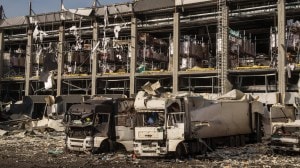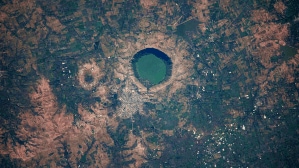India’s aviation safety regulator, the Directorate General of Civil Aviation (DGCA), on Monday even issued an urgent operational advisory to all Indian airlines asking them to strictly avoid volcanic ash-affected areas and flight altitudes. It also directed carriers to adjust flight planning, routing, and fuel considerations accordingly, and immediately report any suspected ash encounter, “including engine performance anomalies or cabin smoke/odour”.

Following the eruption, reported as the first for Hayli Gubbi in around 12,000 years, the ash clouds have since drifted over various countries, including Yemen, Oman, Pakistan, and parts of India. The ash clouds entered India on Monday from Gujarat and Rajasthan, and then moved towards Delhi and Uttar Pradesh, in the southwest to north-easterly direction. These are expected to move fully into China by Tuesday evening. The eruption had set thick plumes of smoke and volcanic ash up to 14 km into the sky.
But why is volcanic ash such a major concern for the aviation sector? Why do aircraft try to avoid volcanic ash-affected areas and altitudes like the plague?
Volcanic ash particles are extremely abrasive and can clog important sensors, impair pneumatics, make the cockpit windscreens opaque, but more critically, they can damage the turbine blades of the aircraft engine and lead to it stalling or flaming out. Along with abrasive particles, volcanic ash clouds also contain some toxic gases that can potentially enter the aircraft’s ventilation system as well. This could lead to a drop in the cabin’s air quality and cause respiratory troubles.
Enemy of the jet engine
From an aviation safety perspective, the most significant threat posed by volcanic ash is to aircraft engines. A jet engine draws in air, compresses it, and ignites it by mixing it with aviation fuel. The resultant high-pressure gases rush backwards, which in turn pushes the engine and the plane forward. Proper balance between airflow and jet fuel is crucial for the jet engine to function, and a disruption in airflow could lead to an engine flameout or shutdown.
The hottest part of a jet engine heats up to over 1,500 degrees Celsius, while volcanic ash, which contains a lot of silica, melts at around 1,000 degrees. When volcanic ash, which is effectively like powdered glass, enters the engine’s combustion chamber, it melts and changes into something very similar to molten glass. This then goes to the turbine blades of the engine, and could easily form a layer of molten glass on them. This layer could effectively prevent the blades from functioning properly, which could result in the engine shutting down. And if all engines shut down, the plane is effectively a glider.
Story continues below this ad
If that happens, pilots are required to shut the engines down and glide the aircraft down through cold air. The cold air, as it passes through the engine, shatters the glass layer on the turbine blades. If all goes well, the engines can resume working, at least enough to allow the plane to divert to the nearest airport and land safely. Some of the damage to the engines and their innumerable components from volcanic ash could end up being permanent. In a sector that is laser-focused on safety, it is just not worth the risk.
Past scares
The aviation sector’s dread of volcanic ash is not theoretical or hypothetical. There have been incidents in the past that show just how real and present the danger is following a volcanic eruption.
In 1982, a British Airways Boeing 747 aircraft operating a flight from London to New Zealand’s Auckland flew into a cloud of volcanic ash that was spewed into the air from the eruption of Mount Galunggung in Indonesia. All four engines of the 747 shut down after encountering the ash. Fortunately, the pilots were able to glide the plane away from the ash cloud and were successful in restarting the engines, after which the plane diverted to Jakarta and landed there. A number of engine parts were found to have been damaged significantly from volcanic ash particles, and the pilots’ windscreens were also sandblasted by the ash, impairing their ability to see outside the aircraft as they flew.
Then in 1989, all four engines of a KLM Boeing 747 failed when the aircraft, which was less than six months old, flew through a thick volcanic ash cloud from Mount Redoubt in Alaska, which had erupted a day earlier. The pilots of the aircraft, flying to Tokyo from Amsterdam, failed in the first few attempts to restart the engines, but eventually succeeded. The aircraft then diverted to Anchorage in Alaska. All four engines had suffered significant damage and had to be replaced. The incident caused over $80-million worth of damage to the aircraft.
Story continues below this ad
DGCA’s urgent advisory on Hayli Gubbi ash clouds
The DGCA on Monday asked Indian airlines to conduct post-flight engine and airframe inspections for aircraft operating near the affected areas, and suspend or delay operations to impacted airports if conditions worsen. They were also asked to monitor for engine performance fluctuations, cabin smoke or odour events, weather changes affecting ash dispersion, and ensure compliance with aircraft manufacturer recommendations and volcanic ash guidance material from the International Civil Aviation Organization (ICAO).
The DGCA also directed the airlines to brief concerned personnel and ensure full adherence to the relevant procedures prescribed in operational manuals. Flight dispatchers were directed to continuously monitor volcanic ash advisories, satellite imagery, meteorological data, and ash movement forecasts.
“If volcanic ash affects an airport, the operators (airlines) may advise immediate inspection of runways, taxiways, and aprons to be conducted,” the DGCA advisory read. It added that airport operations “may be restricted or suspended” based on contamination, and cleaning procedures must be completed before resumption of operations.
While there have been a few flight cancellations and delays, the impact on Indian carriers’ operations has not been significant so far, but airlines are closely monitoring the situation in line with the DGCA advisory. Tata group airline Air India said that it cancelled 11 flights between Monday and Tuesday due to precautionary checks on its aircraft that had flown over certain areas after the Hayli Gubbi eruption. A few IndiGo and Akasa Air flights are also learnt to have been cancelled or delayed.
Story continues below this ad
“Our ground teams across the network are keeping passengers updated on their flight status and are providing immediate assistance, including hotel accommodation. We are making every effort to arrange alternative travel at the earliest. We sincerely regret the inconvenience caused to passengers due to this unforeseen situation beyond our control. The safety of our passengers and crew remains our highest priority,” Air India said in a passenger advisory on Tuesday.
On Monday night, IndiGo had said, “Our teams are closely tracking the situation in coordination with international aviation bodies. We are fully prepared with all necessary precautions to ensure safe and reliable operations. Our 6E teams are available across all touchpoints to support you with any assistance you may need. We will continue to monitor the developments round the clock and keep you informed of any updates to help minimise inconvenience (if any).”








































